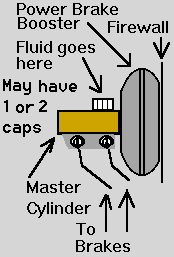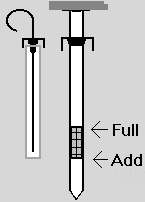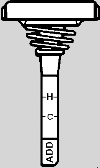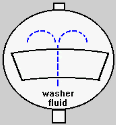AutoTips
Introduction to car maintenance.
New to car maintenance? Here are a few tips for
basic care care .
Some common routine maintenance items for your automobile.
Getting started
- The most common automobile maintenance items involve
simple inspection and occasionally replacing some items on your car.
- Maintenance items include tires, belts, hoses, anti-freeze,
oil, brake & power steering fluids, etc.
- This page is for the beginner covering some common car
maintenance. If you wish to have someone else perform the work, check
out the Finding a good repair shop links.
Often overlooked, some routine maintenance can extend
the time the car performs like new, and reduce the number of breakdowns
on the road.
Sketches on this page are only to indicate a rough idea
of what the parts may look like on your car. Always check the container
to be sure it is what you think before adding fluids. Many mechanics have
stories of customers who have added the wrong fluid to the engine or other
component, and caused significant problems.
On this page: Outside
checks
Under the hood: Opening the Hood Battery
Belts Brake Fluid
Coolant Power Steering
Oil Transmission
Fluid Checking Tire Pressure Washer
Fluid What to carry
Finding a good car repair shop
Additional info and pictures under the hood at the AutoTips
Under the Hood page.
Safety: There are many safety issues working
under the hood of a car. Do the checks below with the engine off. Loose
clothing, ties, etc, should be avoided when working under the hood of a
car. Gloves can protect the hands and safety goggles for the eyes. If
you have any reservations, or are not familiar with what you are doing,
consult a professional auto technician.
Your References:
- The first place to look is the owners manual for your car.
If you don't have one, you can often order one from the dealer's parts
department.

- Repair manuals, available from autoparts stores, often have sections
dealing with the what, where and how of maintenance.
- A factory shop manual may also have maintenance information. They are
often a good source of information to learn how the systems on the car
work.
- A log book you keep with maintenance / repairs performed on car and
receipts.
- The clerk at the local parts store, if you ask them kindly when they
aren't too busy, may help you locate things like the coolant tank, dipsticks,
power steering fluid tank, etc. under the hood of your car.
- A log on your fuel milage, to track changes which may indicate a problem.
For more info, see the AutoTips Miles Per Gallon
page.
Return to top
On the Outside:
Do Frequently:
- Tires - A quick walk around the car can provide a quick check of the
tires.
- Look for low tires.
- Look for bulges, bald spots, or anything unusual.
- A bulge may indicate tire is defective or damaged and unsafe to drive.
- Check the air pressure. (See Checking tire
pressure below.)
- Doors - Seat belts caught between door & frame or hanging out.
- Check for anything low behind your car before backing up.
Check Occasionally
- Wiper Blades -
- Check for torn blades, rough or frayed edges, uneven patterns in the
the rain, should be smooth. They can be carefully cleaned with soap & water,
or specialty vinyl/rubber cleaner such as Armor All cleaner. The author
has found Armor All Protectant or other vinyl / rubber conditioner on the
blades can extend the life. Products such as Rain X applied to the windshield
can cause water to bead up and blow away while driving.
- Head & tail lights, turn signals -
- Have friend step on brakes while you check brake lights.
- Leaks, drips - Look around car on the ground for leaks.
- Coolant (often green or orange), oil (brown), automatic transmission
fluid (red), or other fluids. etc.
- Note air conditioners will drip water condensed from the air to the
ground. (normal).
- Gasoline, may detect odor, but may evaporate if leaking.
- Look for anything unusual under car, dangling cable, etc.
- Doors -
- The latches need periodic lubrication. Most manufacturers recommend
a lithium grease or stick lubricant. Some recommend silicone spray
for the door seals to help prevent water from sticking in the winter and
freezing the doors shut. A spray lubricant may be used in the door locks
for the same purpose.
- Tires -
- Check the tread for adequate depth and even tire wear along the edges.
- Uneven wear (such as deep tread on the outside edge of the tire, but
not the side toward the center of the car, or vice versa) can indicate
need for an alignment or other problems such as under or over inflation,
or parts under the car that need replacing.
- For a lot more information on tires, see the Tire
Safety web site. (use your back button to return to AutoTips)
|
 |
Return to top
Under the Hood Maintenance:
Battery 
- Check the battery cables for snug fit, no frayed ends at connectors,
or breaks in the insulation where it might short out against a car part.
- It is extremely important not to let any metal objects short
out across the terminals, or from the positive terminal to the car body
or other parts under the hood. Use caution with tools near the battery.
- Corrosion should be cleaned off the terminals.
- If you are just starting out in car care, you may want to look
in a shop manual or ask a professional for help on the proper method to
clean the terminals. Also see the safety tips on the AutoTips
jump start page.
- When to replace - Newer batteries often fail with little or
no warning. It is good to carry a set of jumper cables. If you start
to notice the engine turns over slowly, you could have a weak battery,
or a weak charging system. Some autoparts stores can check the battery
or charging system for you free of charge. It has been the author's experience
not all store clerks are properly trained to use this equipment.
Return to top
BELTS
- Some cars some have multiple belts, some have a single belt (called
a serpentine belt). The belts are used to run the alternator, water
pump, power steering, air conditioner compressor, and in some cases air
pump. (used in pollution controls)
- Look for small cracks, tears, frayed, or glazing.
- If you see these, it may be time to have them replaced.
- You can carry spares in your vehicle so if they break. It is much better
to have belts replaced before they break, then have them break while driving
down the road.
- If a bearing in an accessory goes bad and locks up, (such as air conditioner)
it can cause a loud squealing as the belt tries to turn it. This can cause
a rapid belt failure.
- Timing belts are under a cover and need to be periodically replaced.
- Many car makers recommend replacing these at least every 60,000 miles.
Check your owners manual or with a dealer. Timing belts may give
no warning when they fail, leaving you stranded.
- On some belts, when the timing belt fails, severe engine damage can
result from pistons hitting valves.
- Not all cars have a timing belt, some use a timing chain, that needs
no periodic replacement.
Return to top
| Brake Fluid is normally added to the master cylinder,
located near the driver's side of the car on the back of the engine compartment.
(firewall). There are various style tanks in addition to the one illustrated.
Some have a metal top with a heavy wire that swings over the top and snaps
in place. Some tanks on the master cylinders are translucent, so you can
see the level, similar to coolant tank, except it doesn't need to be checked
hot. Others have a ring inside the caps for a fill level.
When to change: Some manufacturers recommend having brake fluid flushed
every 1 to 3 years, depending on humidity where you live. Some shops have
machines to do this, or you can do it by a process called bleeding the
brakes.
|
 |
Return to top
Checking coolant level -
What is Coolant? -- Coolant refers to the mix of antifreeze and
water that circulates through the engine, radiator and heater core.
Heat generated in the engine is picked up by the coolant, and
circulated by the water pump through the radiator in the front of the car
and the heater core. Air blowing through the radiator cools the coolant,
and it returns to the engine to cool the engine. In cold weather, coolant
circulating through the heater core is used to provide warm air inside
the passenger compartment.
- Checking coolant:
- In some old cars the coolant level was checked in the radiator by removing
the radiator cap. NOTE: Never open the radiator cap when car is hot.
TIP, using a rag, squeeze the upper radiator hose, if it is hot or firm,
it is still under pressure, and you should wait until it cools to open
the radiator cap. Keep eyes out of the path of the cap when opening, and
use a rag around the cap. Hot coolant can spray out causing serious personal
injury.
- Most newer cars use a coolant reservoir or overflow tank. The coolant
level is checked there, rather than in the radiator, unless the tank is
empty. The coolant expands as picks up heat from the engine,
so the level rises, and that is where the reference level is in the example
below. The HOT in the tank below means the coolant should be to this
level when the engine is hot. (the coolant will contract as the engine
cools)
- The coolant reservoir typically has a level indicated on the tank for
checking the fluid with the engine hot.
- Depending on the car, the small hose to the radiator may be at the
top or bottom of the tank.
- Coolant is usually green or orange. Do not use pure antifreeze. Check
the bottle for proper mixture for the climate where your car will be vs.
freezing temperature. Most areas of the US will work with with 50%
anti-freeze / 50% water mix.
|
 |
When to change:
- For green coolant, recommendations generally are every 1 or 2 years,
depending on the amount of driving, climate, etc.
- For the extended life (orange) coolant, original recommendations were
every 5 years, however auto technicians are finding some problems with
this coolant on some vehicles if left in this long.
- Look for color change, if there is a lot of scale, or dark deposits
in the tank, it may be time for a change.
- Some manufacturers recommend using de-mineralized or distilled water
to mix with the anti-freeze.
- Hoses
- Coolant
- There are typically upper and lower radiator hoses, heater hoses, a
bypass hose, and possibly others.
- The upper and lower radiator hoses are the largest. Heater hoses are
smaller.
- Look for bulging, leaks, stiff areas, cracks at end of hoses.
- Coolant hoses often break in the worst weather. It may be best
to have these periodically replaced before they break. Hoses vary widely
in quality, lower cost hoses can be thinner, and may not seal as well at
fittings.
- Vacuum
- Smaller, roughly 1/4" to under an inch in diameter.
- Used around engine, on power brake booster, cruise control.
- Look for cracks, stiff ends. Often vacuum hoses can leak as they become
stiff, one of many possible causes for rough idle, rough running, and poor
fuel economy.
- Before bending too much, have spares, as they can become brittle.
Return to top
OIL -
- Lubricates and cools engine.
- Oil is in a severe environment inside the engine, and is subject to
breakdown of lubricating qualities from various factors.
- Oil can be lost through leaks, and burning.
- As the oil level drops, the rate the oil degrades can increase, and
engine wear can increase.
- If oil becomes too low, the engine can over heat or even seize up.
Checking Engine Oil Level
- A dipstick is used to check engine oil. A couple of styles are on the
right.
- Goes into tube on side of engine. (not to be confused with transmission
- which also has a dipstick)
- Oil is a brown or dark honey color.
- To Check Oil
- Engine should be off.
- Car on level surface.
- Pull out dipstick, wipe with rag or paper towel.
- Replace dipstick in tube.
- Slowly pull out, look for oil level on stick.
- For most cars, if the oil level is down to the add line, it is one
quart low.
- If you have just shut off your car, you may want to allow a few minutes
for the oil to drain back into the pan to obtain the most accurate measurement.
|
 |
 Add oil as specified
in your owners manual, or look for a tag under the hood of your car as
to type of oil to use.
Add oil as specified
in your owners manual, or look for a tag under the hood of your car as
to type of oil to use. - Motor oil is rated by a thickness rating (viscosity) over a specified
temperature range. Most cars will call out oil with ratings such as 10W-30.
There should be an place to add oil on the top of the engine.
When to change oil:
- Opinions vary widely, note the manuals in cars often list several sets
of conditions.
- For example, a manual may say change every 7,500 miles under normal
conditions, and every 3,000 miles under any of the following conditions:
- Stop and go driving.
- Frequent short trips.
- Severe weather, or in dusty climates.
- When pulling a trailer.
- Many auto technicians suggest a 3,000 mile interval.
- Some manufacturers recommend every 3 or 4 months if you haven't already
changed because of milage.
- Changing more often than the minimum required will not hurt, and may
extend engine life.
- As oil breaks down during normal driving, engine wear increases
- Allows for increased rate of oil contamination and consumption.
- As wear engine increases, performance and milage drop.
- The oil and oil filter are normally changed at the same time.
- Check your oil level after it is changed, even by a shop.
- Many auto manufacturers do not recommend the use of oil additives.
- Synthetic oils are more expensive, but offer several advantages including
easier starting in very cold weather.
Return to top
Power Steering
 |
The power steering pump is driven by a belt.
- Sometimes there is a small tank on top of the pump, or sometimes there
is a separate tank away from the pump.
- There may be either a dipstick as shown in the image at right, or a
level line similar to the one on the coolant tank.
- The H & C refer to the full level points with the engine hot
or cold.
- It may take only a few ounces in some cases to go from add to full.
- Some cars use Power Steering Fluid, some use automatic transmission
fluid in the power steering. It is important to use the right type. Many
auto parts stores will have a listing the right type for your car.
- When to change: Not often listed as a maintenance item, although if
it gets dirty, you can change it. (A change has been found to ease steering
at times in cold weather. Synthetic
blend power steering fluid can also help in cold
weather.) See the AutoTips Partial Transmission Fluid
Change page for an idea of how to change power steering fluid.
- If the power steering squeals when you turn can be a sign of low fluid
level and / or loose, worn belt.
|
 |
Return to top
Transmission Fluid -
Return to top
Windshield Washer Fluid
 |
- Look for a translucent container under the hood, sometimes with a windshield
wiper and / or washer symbol or on the lid, or a label such as "windshield
washer fluid".
- Note there are some types of washer fluid that are rated for summer
only, and not good below freezing.
|
 |
Return to top
Tires:
How to check tire pressure:
 The chuck end of the gauge.
The chuck end of the gauge.
Copyright AutoTips.






 Add oil as specified
in your owners manual, or look for a tag under the hood of your car as
to type of oil to use.
Add oil as specified
in your owners manual, or look for a tag under the hood of your car as
to type of oil to use. 



The chuck end of the gauge.